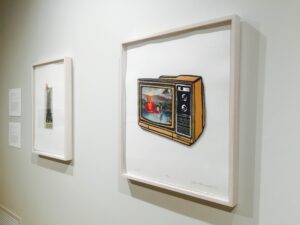Pace Prints: A Master Printer’s Perspective is currently on display at St. Olaf College’s Flaten Art Museum! The show opened on September 10th (so I am a bit late with the update), but it is open until November 8th. Still plenty of time to check out these amazing prints. Here is the official blurb:
Fine art publisher Pace Prints issues work by some of the world’s most celebrated contemporary artists. Lesser-known are the master printers, whose technical expertise allows these artists to achieve the precise effects desired in their prints and whose innovations push the boundaries of the medium. This exhibition explores the intertwined relationship between artist and master printer through a collection of more than 20 prints including etchings, lithographs, monoprints, silk screens, woodcuts, and new technologies that synthesize digital tools and traditional approaches. Contemporary artists such as Ghada Amer and Reza Farkondeh, Chuck Close, Tara Donovan, Sol Lewitt, Claes Oldenberg, Kiki Smith, and James Turrell have partnered with Pace, collaborating with master printers to solve thrilling technical puzzles and challenge the boundaries of contemporary printmaking. Curated by Bill Hall, Master Printer, Pace Prints; Justin Israels, Master Printer, Pace Prints; John Saurer, Associate Professor of Art, St. Olaf; Jane Becker Nelson, Director, Flaten Art Museum.
It was great to  be in the audience for the gallery talk by Justin Israels (Master Printer of Pace Prints) on September 25th, who spoke about the many works on display as “old friends.” Printmaking is collaborative by its very nature, and it was a refreshing perspective on works that sometimes never escape the aura, personality, or dominant narrative of the artist. It was fascinating hear about the challenges involved with finding the right sized pin to create Tara Donovan’s pin matrix relief prints or learning about the process needed to make Corban Walker’s hardground etchings. In all cases, these works would have never been possible without the synergy of the artist’s vision and the technical skill of the printer, whose identity often remains hidden from view.
be in the audience for the gallery talk by Justin Israels (Master Printer of Pace Prints) on September 25th, who spoke about the many works on display as “old friends.” Printmaking is collaborative by its very nature, and it was a refreshing perspective on works that sometimes never escape the aura, personality, or dominant narrative of the artist. It was fascinating hear about the challenges involved with finding the right sized pin to create Tara Donovan’s pin matrix relief prints or learning about the process needed to make Corban Walker’s hardground etchings. In all cases, these works would have never been possible without the synergy of the artist’s vision and the technical skill of the printer, whose identity often remains hidden from view.
There are a wide range of prints on display to showcase a variety of processes, but my two favorites were Rhexia by Paul Morrison (2011, linocut, printed by Justin Israels, Kathy Kuehn Bill Hall, Ann Aspinwall & Kyle Simon) and Faith by Jane Hammond (2001, iris print with relief, collage, wood veneer, silver foil, and hand-coloring printed by Ruth Lingen, Kathy Kuehn, Mae Shore, and Andre Ribuoli). The former because it toyed with the visual codes of older landscape prints writ large, playing with scale and style in one gigantic linocut. The latter because who cannot forget the image of a sinking Kamakura daibutsu, candles, and a ballerina on a retro television set. It reminded me of the strange imagery of a tourist poster with the pastel background punctuated by bold forms. Although none were featured at the Flaten Art Museum, Pace Prints has also worked with Japanese artists such as Okada Kenzo, Shibata Yasu, and Nara Yoshitomo.
The secret labor of the printer is nothing new, however! I have been working with nineteenth-century woodblock printed engravings, and I also find that the identity of the printer or engraver, if known, is always overshadowed by the author of the text. Even when the images found in these works become iconic, they are exclusively associated with the writer.